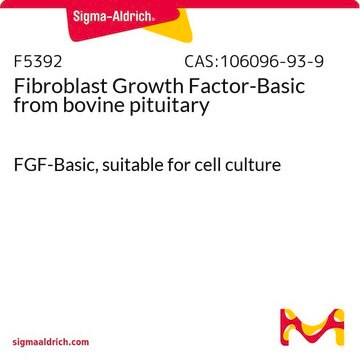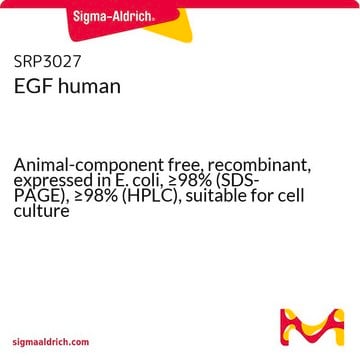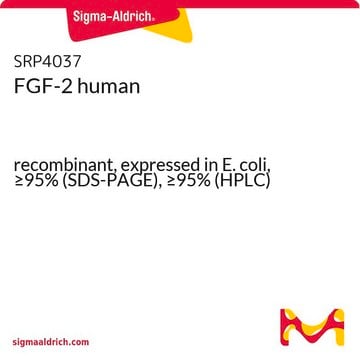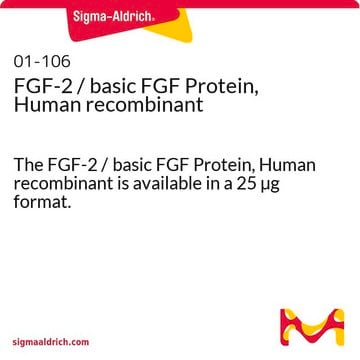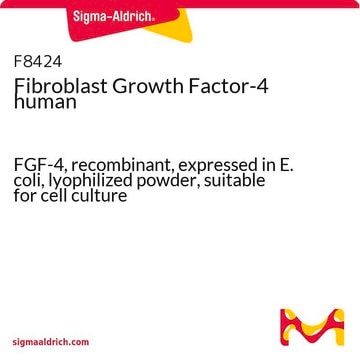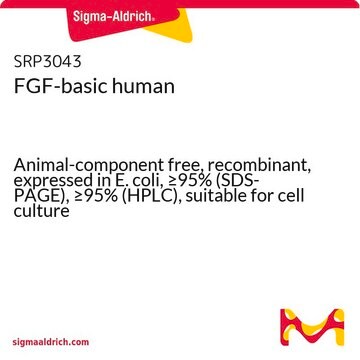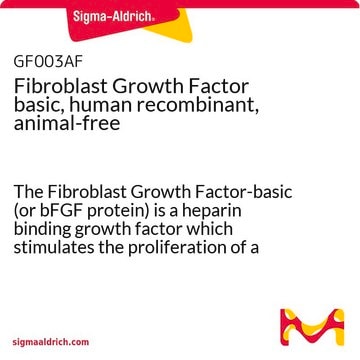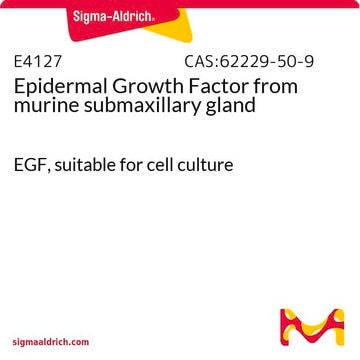F3133
Fibroblast Growth Factor from bovine pituitary
lyophilized, suitable for cell culture
Synonym(s):
FGF
Sign Into View Organizational & Contract Pricing
All Photos(1)
About This Item
Recommended Products
Product Name
Fibroblast Growth Factor from bovine pituitary, suitable for cell culture
biological source
bovine pituitary glands
Quality Level
form
lyophilized powder
potency
1-100 ng/mL
mol wt
16.4 kDa
packaging
pkg of 10 and 5X10 μg
storage condition
avoid repeated freeze/thaw cycles
technique(s)
cell culture | mammalian: suitable
impurities
endotoxin, tested
color
white to off-white
storage temp.
−20°C
Looking for similar products? Visit Product Comparison Guide
General description
Fibroblast growth factors (FGF) are glycoproteins concealed in the extracellular matrix and cell surface. There are around 22 different types of FGFs known. These factors weigh in the range of 17 to 34kDa and they possess a conserved sequence of 120 amino acids.
Application
A natural mitogenic growth factor used in cell culture applications to study cell signaling and to promote fibroblast and endothelial cell growth and survival.
Fibroblast Growth Factor from bovine pituitary has been used in in vitro testicular cell culture. It has also been used as a component of myogenic culture medium.
Biochem/physiol Actions
Fibroblast growth factors (FGF) actively participate in cellular responses including embryogenesis and organogenesis. It specifically controls cell proliferation, differentiation and migration. FGF is known to regulate nervous system functions, tissue repair mechanism and wound healing. It also controls angiogenesis of tumor cells. Abnormal FGF mediated signaling induces tumor angiogenesis, by stimulating cancer cell proliferation and survival. FGFs carries out its function by mediating through four receptor tyrosine kinases : FGF-receptors FGFR1, FGFR2, FGFR3 and FGFR4.
Quality
Although the major mitogenic component of this product is FGF2, the activity per unit weight of protein is less than that of purified FGF2.
Physical form
Lyophilized from a 0.2 μm filtered solution in phosphate buffered saline containing 0.1 mg/ml BSA.
Preparation Note
Purified glands by a modification of the method of Gospodarowicz.
Analysis Note
The biological activity is measured using a 3-day MTT assay.
Storage Class Code
11 - Combustible Solids
WGK
WGK 3
Flash Point(F)
Not applicable
Flash Point(C)
Not applicable
Personal Protective Equipment
dust mask type N95 (US), Eyeshields, Gloves
Choose from one of the most recent versions:
Already Own This Product?
Find documentation for the products that you have recently purchased in the Document Library.
Customers Also Viewed
Characterization and In Vitro Differentiation of Korean Ring-Necked Pheasant (Phasianus colchicus) Male Germ Cells
Jeong DK, et al.
Journal of Embryology transfer , 29(4), 351-359 (2014)
Modulation of osteogenic, adipogenic and myogenic differentiation of mesenchymal stem cells by submicron grooved topography
Wang PY, et al.
Journal of Materials Science. Materials in Medicine, 23(12), 3015-3028 (2012)
Fibroblast growth factor signalling: from development to cancer
Turner N and Grose R
Nature Reviews. Cancer, 10(2), 116-116 (2010)
A testis-mediated germline chimera production based on transfer of chicken testicular cells directly into heterologous testes
Lee YM, et al.
Biology of Reproduction, 75(3), 380-386 (2006)
Identification, culture, and characterization of germline stem cell-like cells in chicken testes
Jung JG, et al.
Biology of Reproduction, 76(1), 173-182 (2007)
Our team of scientists has experience in all areas of research including Life Science, Material Science, Chemical Synthesis, Chromatography, Analytical and many others.
Contact Technical Service